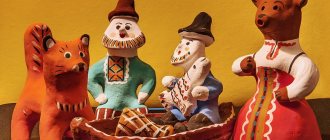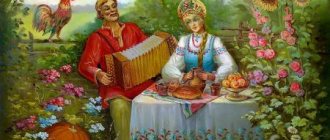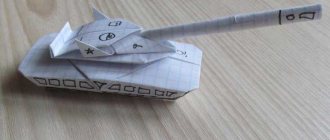Organization of a subject-development environment in a preschool educational institution on the topic: Folk crafts
Organization of a subject-developing spatial environment on the topic: “Folk crafts” in the educational field “Cognitive Development”
Author: Alla Ivanovna Efimova, teacher of GBDOU No. 43, Kolpino St. Petersburg Description: The material will be useful to educators and also interesting to parents. The material was accompanied by a presentation. Preschool age is the age of formation and development of the most general abilities, which will improve and differentiate as the child grows up. One of the most important abilities is the ability to cognition. Objectives of cognitive development: • To cultivate respect for the work of folk craftsmen. • To form positive emotional responsiveness when perceiving the works of folk artists. • Expand and consolidate children's ideas about Russian folk crafts. • Develop creative imagination, their independence in coming up with a drawing. • Enrich children's vocabulary. • Develop coherent speech. • Develop attention and cognitive activity. • Develop logical thinking and memory. (slide 2; 3) It is necessary to organize interaction with the child in such a way that it is aimed at developing cognitive interest, cognitive independence and initiative. The main forms of interaction that promote cognitive development: - involving the child in various types of activities; - use of didactic games; - application of teaching methods aimed at enriching creative imagination, thinking, memory, and speech development. Cognitive development involves the cognitive activity of a preschooler. And in order to support cognitive activity, it is necessary to rely on the cognitive interest of children. Folk decorative and applied art is one of the means of aesthetic education, helps to form artistic taste, teaches children to see and understand the beauty in the life around us and in art. Introducing children to folk art and crafts has a beneficial effect on the development of children's creativity. The nature of folk art, its emotionality, colorfulness, and uniqueness are effective means for developing mental activity in children and the all-round development of the child. The creativity of folk artists not only cultivates aesthetic taste in children, but also forms spiritual needs, feelings of patriotism, national pride, high citizenship and humanity. The child learns that wonderful colorful objects are created by folk craftsmen, people gifted with imagination, talent and kindness. (slide 4)
To form and develop cognitive interest, one should: - develop children’s creative abilities, create conditions for this, - strengthen each child’s faith in his own abilities, encourage him, and not weaken his interest with distrust and negative assessments; develop children's self-esteem. Folk arts and crafts participate in the comprehensive development of children, delighting them, expanding their concepts and ideas, and cultivating artistic taste. (Slide5) » Once upon a time there lived a miracle master. He settled in a deep forest, built a hut, made a table and a spoon, and carved wooden dishes. He cooked wheat porridge, but did not forget to sprinkle millet on the chicks. Once a firebird flew to his house, touched the cup with its wing, and it turned golden. And since then beauty has appeared - painted dishes! “You can ask your child a riddle: “All the leaves are like leaves, here every one is golden, people call this beauty... (Khokhloma). (slide 6;7;)
“Vesely Gorodets” There is an ancient city on the Volga, named Gorodets. He is famous throughout Russia for his painting, the creator. Bouquets are blooming, Bright colors of grief. It’s a miracle - birds flutter there, as if calling us to a fairy tale. If you look at the tablets, you will see miracles! Gorodets patterns were subtly drawn by hand! The Gorodets horse is running - the whole earth is trembling under it! It’s a miracle - birds flutter there, And water lilies bloom! As if calling us to a fairy tale! (slide8;9)
In the course of familiarization with a particular craft, appropriate material is introduced into the playing corners. Practical material and teaching aids have been selected, which include authentic items of folk crafts - Khokhloma, Dymkovo toys, Zhostovo, nesting dolls, Filimonovskaya toys, Gorodets products; illustrations, albums for each type of folk art. Some teaching aids were created with your own hands: - Puzzles - d/i “Assemble a pattern” - d/i “Assemble a fairy tale” - “Find a pair” - “Which fairy tale is the hero from?” etc. (slide 10;11;12) Works of oral folk art have enormous cognitive and educational significance, contribute to the development of imaginative thinking, and enrich children’s speech. Folklore provides excellent examples of the Russian language, by imitating which a child learns his native language. Riddles, proverbs, sayings, nursery rhymes allow children to broaden their horizons, get to know better the life and way of life of the Russian people, their wisdom, and help to form a sense of patriotism and love for their native land. The cognitive significance of folklore is manifested, first of all, in the fact that it reflects the characteristics of real life phenomena and provides rich knowledge about social relations. Folk arts and crafts are one of the important means of artistic education for preschool children. Early development of creativity, already in preschool childhood, is the key to future success. (Slide 13;14;15) One of the most extensive sections of folk art and the most beloved by children is fairy tales. The Russian people have a whole storehouse of priceless pearls of this genre. Fairy tales teach children justice, honesty, and nobility, which is why they are used more than other genres in working with preschool children. When introducing children to a particular fairy tale, it is important not only to bring them joy, but also to bring to their consciousness the main idea of the work and teach them to evaluate the actions of the heroes. Illustrations are of great importance in the correct perception of a particular work by children. To enrich the vocabulary and assimilate by children the words that characterize folk speech, it is important to show colorful illustrations to fairy tales, while emphasizing the national flavor of household items, clothing, and the environment in which the characters act. The systematic and systematic use of various types of fairy tales forms children's interest in folk art. Children reflect the impressions they receive from fairy tales in games and drawings. And the children’s speech is significantly enriched. When talking to each other, they often use figurative expressions and epithets from fairy tales. (slide 16;17;18) Conversations were held with children, they looked at paintings and illustrations with different types of decorative art. Parents were given tasks to bring various attributes, illustrations, and design work on different types of decorative and applied arts in format A - 4. (slide 19) We see one of the important tasks of work on this topic as creating a versatile developmental environment for each child in order to give him the opportunity to express himself. myself. In the “art center” I picked up didactic and educational games; folders with silhouette modeling, various illustrated materials on the topics “Gzhel”, “Dymka”, “Khokhloma”, “Filimonovskie”, “Zhostovo”, etc., designed tables with elements of folk paintings, created conditions for independent activities, various illustrated materials, were Authentic items of decorative and applied art and poster models were purchased to develop the ability to plan work to implement a plan. During work, we awaken in the child faith in his creative abilities, individuality, uniqueness, the belief that it is very important to create goodness and beauty, to bring joy to people. Namely, among the large number of standard dishes, for the sake of accessibility of materials, there are wooden cups, spoons in the style of Khokhloma painting, a samovar, and scarves (for dressing up). (slide 19) It is important to ensure periodic rotation of toys and materials, update existing corners and zones, and also make changes to the order of group organization. "Mini exhibition of handicrafts." (slide 20) Decorative and applied arts enrich children’s creative aspirations to transform the world, develop in children non-standard thinking, freedom, emancipation, individuality, and the ability to peer and observe. In our kindergarten, much attention is paid to introducing children to the origins of folk culture. We live where there is no opportunity to see the direct technological process of making artistic dishes, household items and toys, there are no museums. But we need to give children the joy of creativity, introduce them to the history of folk art, show them the basics of modeling and working with a brush, and introduce them to the figurative stylization of plant and geometric patterns. So that every child feels proud of being a citizen of Russia. Teach children to play with their great-grandmothers’ toys, teach them how to build such toys. (slide 21) The use of Russian folk games as a means of physical education contributes to the formation and improvement of motor skills, increasing the functionality of all systems and organs of the body, the formation of personal qualities and positive character traits. Folk outdoor games help clarify ideas about the world around us, broaden our horizons, and improve mental and physical qualities. CARD INDEX OF RUSSIAN FOLK ACTIVITY GAMES The accumulation of all kinds of folk crafts leads to the creation of an enriched subject-development environment in the group. The results of the work carried out are: 1. Children use nursery rhymes, counting rhymes, riddles, and chants in active speech. 2. They know how to play Russian folk outdoor games using counting rhymes. 3. They have a rich knowledge of fairy tales and fairy-tale characters, and are able to recognize them in works of fine art. 4. Meaningful and active participation of children in Russian folk holidays (they know the name of the holiday, sing songs, perform ditties, read poetry). 5. Use the attributes of Russian folk culture in independent activities. 6. Treat household items and works of folk art with care. Thus, this system of work allows preschool children to develop knowledge about the cultural heritage of the Russian people. The work is based on the formation of an emotionally charged sense of children’s involvement in the heritage of the past, including through the creation of a special environment that allows them to come into direct contact with it. The upbringing and development of a child, including creative development, is impossible without the participation of parents. In order for parents to become like-minded people and create the necessary conditions for the creative development of their children, it is necessary to captivate and provide the necessary methodological assistance. Parents receive the necessary information at meetings, in individual conversations, consultations, through information stands on the topics: “Teaching to understand beauty”, etc. I designed a sliding folder “Russian festive costume”, “Where the nesting doll came to us from”, etc. The result of such days exhibitions of joint creativity are becoming, where everyone can admire the creation of their own hands. The results of the work done allow us to conclude that the use of folk crafts deepens children's knowledge of folk art, develops aesthetic taste, and enriches visual creativity. Most students are able to distinguish between products of different folk crafts and draw patterns based on products of folk arts and crafts. Preschoolers skillfully and freely use not only a brush, but also unconventional methods of creating patterns, independently outline the sequence of making products, and control their own actions with verbal explanation. Children in our group are able to identify means of expression, elements of patterns, color combinations, coloring, and a symmetrical pattern of a composition characteristic of a particular painting. Our little artists actively use their acquired knowledge and skills in independent creative activities.
We recommend watching:
My favorite Kuban kindergarten Corner of theatrical activities for children of the first junior group Duty corner in kindergarten
Master Class. Twine well
Similar articles:
Do-it-yourself panels for decorating a corner of nature in a kindergarten
Aerodesign. Master Class



